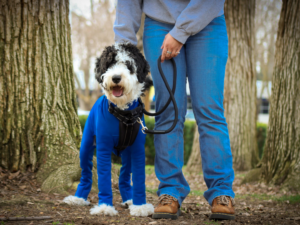3 Helpful Tips to Keep Your Dog Warm and Safe This Winter
With cold temperatures and plenty of rain and snow across the nation, it’s important for dog owners to think about how to keep their dogs warm and safe all winter long. If you live in an area that sees plenty of cold conditions like snow, wind or rain, you know what a challenge this can be, especially if your dog is prone to getting cold easily.
In this post, we’ll go over 3 helpful tips to keep your furry friends safe and introduce two of our dog bodysuits that can help protect and keep them warm all season.
1) Monitor Your Dog’s Behavior While Outside
 When you enjoy snowy hikes or going for brisk winter walks, it’s important to monitor your dog’s behavior and watch for signs that they’re getting too cold. Some common signs include shivering, muscle stiffness, and lethargy, which can lead to hypothermia, according to PetMD. If you notice any of these behaviors, get inside or find a warm and sheltered spot for your dog to rest as soon as possible.
When you enjoy snowy hikes or going for brisk winter walks, it’s important to monitor your dog’s behavior and watch for signs that they’re getting too cold. Some common signs include shivering, muscle stiffness, and lethargy, which can lead to hypothermia, according to PetMD. If you notice any of these behaviors, get inside or find a warm and sheltered spot for your dog to rest as soon as possible.
If your dog has to spend a longer amount of time outside, make sure they have access to a warm, covered area. This could be a dog house or an insulated shed with blankets and bedding inside. While some dog owners might have reservations about heated dog beds, the American Kennel Club says they’re not only safe, but can be beneficial for senior dogs, as well as dog breeds that tend to get cold easily (such as Vizslas, German Shorthaired Pointers, etc).
Always use a heated dog bed that’s specifically designed for dogs and follow all manufacturer’s instructions for use.
2) Limit Your Dog’s Exposure to the Rain and Snow
Another important factor to consider when you want to keep your dog warm and safe in the snow or protected in rainy, windy conditions is the amount of time they spend outside. Try to keep your walks and play sessions short, and make sure your dog has plenty of warm and dry places to rest when they’re outside.
It’s also a good idea to check your dog’s paws and ears frequently for signs of frostbite. According to the American Kennel Club, frostbite can occur when the skin and tissues freeze, resulting in tissue damage in extreme cold. It’s most common on the ears, paws, and tail, so if you notice any redness, swelling, or blisters in these areas, get them inside and warmed up as soon as possible.
If your dog is experiencing any signs of frostbite, such as discoloration or numbness of the skin, contact your veterinarian immediately.
3) Invest in the Right Winter Suit to Keep Your Dog Cozy and Protected
During the winter, the cold weather can be challenging for young and older, senior dogs alike. While some dogs are able to withstand it, many others can’t protect themselves and rely on their owners to provide warm, protective clothing.
There are certain dog breeds that can benefit greatly from wearing warm clothing in the winter, including:
- Senior dogs
- Thin, lean dogs
- Puppies
- Breeds without an undercoat
- Short-haired or thin-coated dogs
- Dogs with weak immune systems
- Small and/or breeds that are low to the ground, and
- Dogs that are recovering from injuries, surgery or illness
One of the best ways to keep your dog warm, dry and comfortable is by investing in a high-quality, form-fitting bodysuit. Here are two K9 Top Coat winter bodysuits that will help keep your dog warm and protected during these chilly winter months.
Arctic Fleece Bodysuit to Keep Your Dog Toasty All Winter Long
 Our Arctic Fleece Bodysuit is lined with Polartec® Power Stretch® micro-fleece material that captures your dog’s own body heat to create a warm thermal layer between the suit and your dog’s body. This process keeps your dog warm and comfortable when the temperature drops. Plus, the smooth outer layer is water-resistant, so it’s great for those winter days with heavy fog, light rain, snowy days or when it’s just plain cold outside.
Our Arctic Fleece Bodysuit is lined with Polartec® Power Stretch® micro-fleece material that captures your dog’s own body heat to create a warm thermal layer between the suit and your dog’s body. This process keeps your dog warm and comfortable when the temperature drops. Plus, the smooth outer layer is water-resistant, so it’s great for those winter days with heavy fog, light rain, snowy days or when it’s just plain cold outside.
If you want to see our Arctic Fleece Bodysuits in action, check out some great posts on our Instagram account from PBJ Pack. Their sister, Pebbles, is a spunky 16-year-old Maltese who still loves going on winter hikes and walks with her brothers.
Weatherproof Bodysuit for All-Weather Protection During the Winter
If your dog is often out on rainy walks, snowy hikes or braving harsh winds, our Weatherproof Bodysuit will help them stay warm and dry. Made using Polartec® Power-Stretch fleece material with Hardface® and Windbloc® technology, its water-repellent exterior provides maximum weather protection.
For some great video of our Weatherproof Bodysuit, check out Sully and Sampson, a couple of Goldendoodle brothers who live life to the fullest through all their adventures!
What’s the Difference Between the Arctic Fleece and Weatherproof Bodysuits?
The difference between the Arctic Fleece Bodysuit and the Weatherproof Bodysuit is subtle, but important to know so you can get the best winter suit for your dog.
Bodysuit Similarities
Both the Arctic Fleece Bodysuit and Weatherproof Bodysuit provide the same coverage and are designed with Polartec ® Power Stretch® fleece as the base fabric. This breathable, four-way stretch material has a smooth exterior and soft microfleece interior that wicks moisture away from your dog.
Bodysuit Differences
The Polartec® material we use for our Arctic Fleece Bodysuit is water-resistant. It also has more stretch and is slightly softer to the touch than our Weatherproof Bodysuit.
The Polartec® material used to make our Weatherproof Bodysuit has added technology that makes it water-repellent and offers increased protection from harsh wind and rainy weather conditions.
How your dog’s bodysuit fits is important to ensure they’re not only warm, but safe and comfortable as well! If you’re ready to find the right size for your dog, check out our Size Gallery to get started.
Conclusion
Winter can be a tough time for our furry friends, but with a little preparation, you can ensure they stay warm and safe this winter. By monitoring their behavior, limiting their exposure to harsh weather conditions, and investing in the right winter gear, you can keep your dog happy and healthy throughout the winter months.
Important Note for Pet Parents:
This post is intended for informational purposes only and is not a substitute for professional veterinary advice, diagnosis or treatment. If you have any concerns about your dog’s health or well-being, always consult with a qualified veterinarian.


